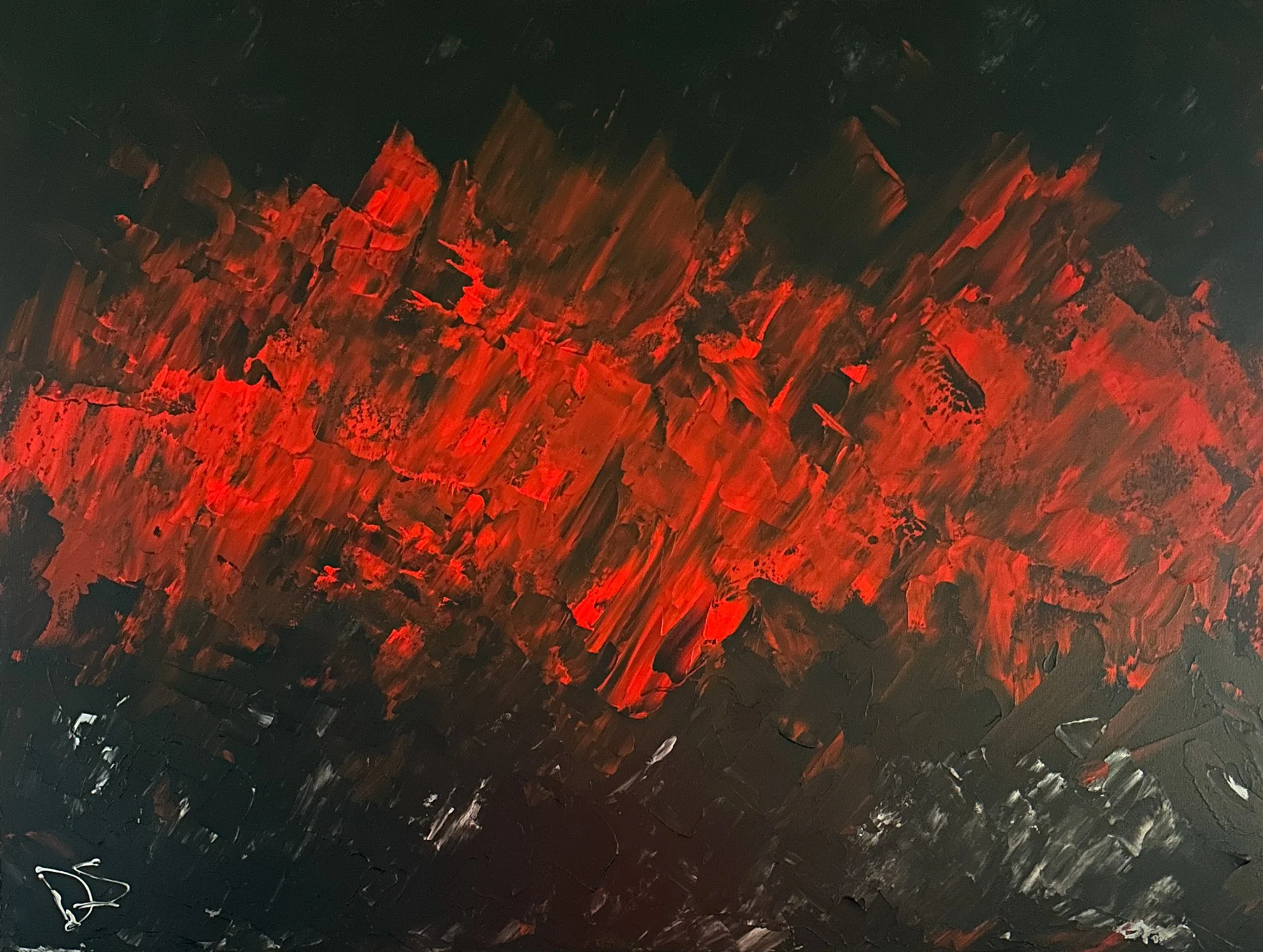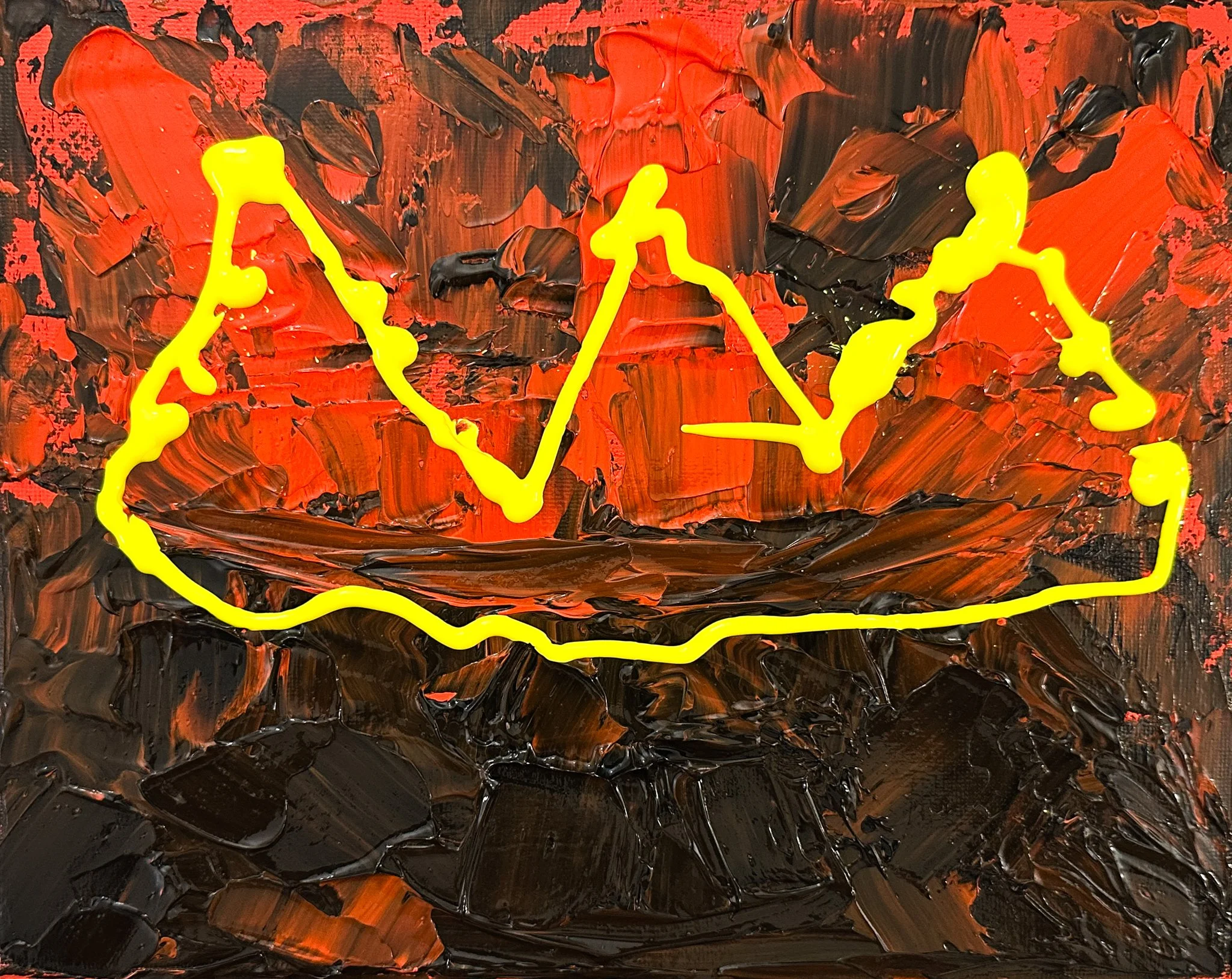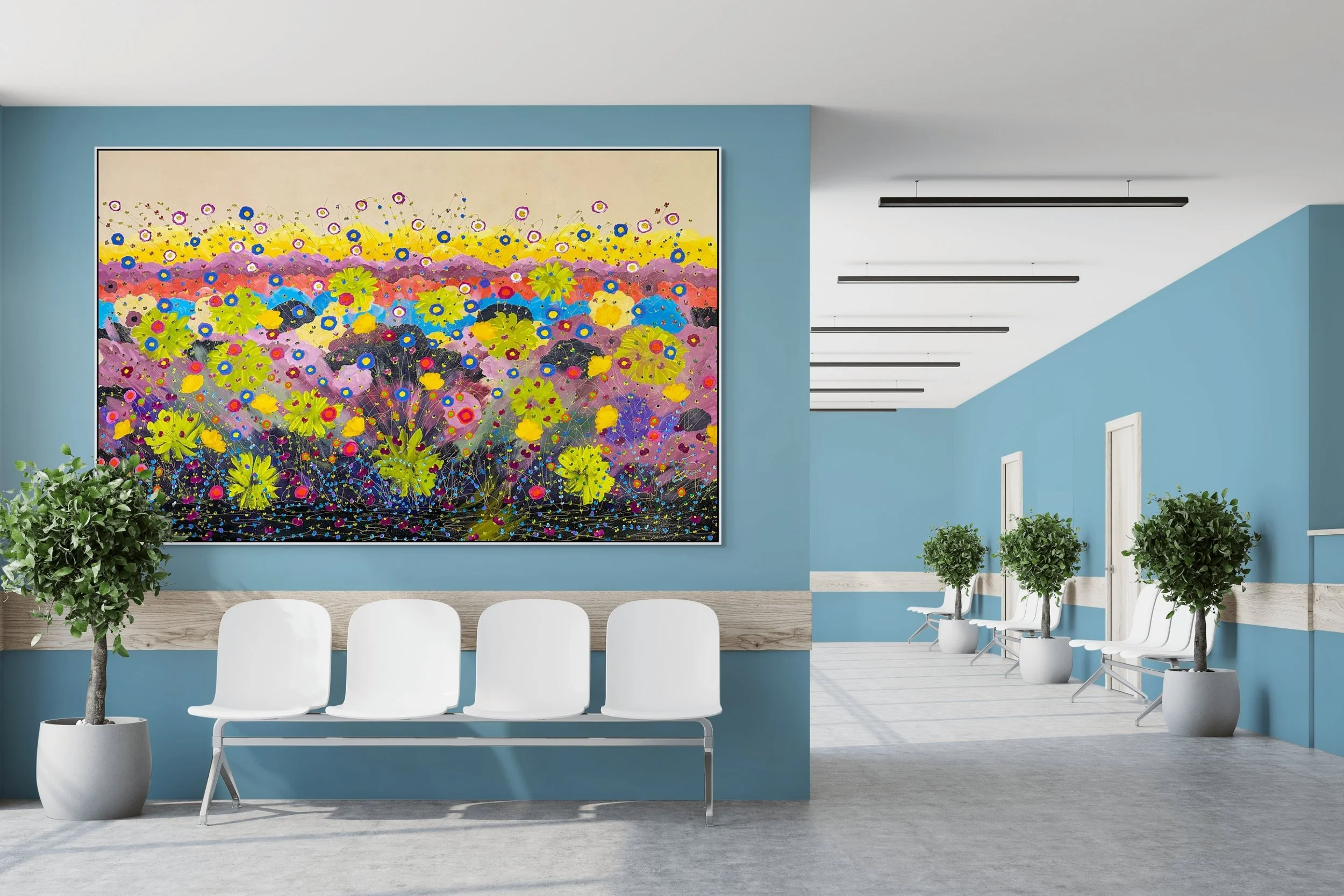At The Heart Of My Evidence-Based Design Art
Art marketing experts and advisors have been telling me for years that I need to pick one art category and paint in it.
I tried to stay in one art category, figuring that my sales figures would eventually show me the right direction to take, but then I kept selling and selling in all of my categories.
Next, I thought I’d find my one big winning category when my art got viewed by art curators from around the world. If you look at my dorotheasandraart.com website’s first page and scroll down to the 2025 International Curations, you’ll laugh. I haven’t posted them all, but right now, I am in 44 different international art curations—and the art curators seem to like my art in all the different categories and styles I paint.
Thankfully, it was my evidence-based design knowledge and training that eventually helped me understand that I really do have one central item running through all of my art:
I discovered that—whether it’s a painting about sustainability, an evidence-based design floral impressionism, a water-inspired movement composition, or even an intense abstract—AT THE HEART of every single one of my paintings are elements of LOVE and CARE.
If the inside of my art could speak, it would say, “In this painting is love and caring about human health and happiness.”
The Happiness Factor by Dorothea Sandra, EDAC, 5’x8’
















Using my Evidence-Based Design Certification (EDAC) training, the colors are bright, cheerful, and welcoming. Viewers can see through the stems, which scientific studies have shown to create safety in human minds. Flowers rooted in soil suggest a continuation of life, unlike cut flowers in a vase, which will soon die. The yellow sun, with its healthy-looking morning glow, gives many viewers the feeling that “survival” will be easy, which creates chemicals in the brain (like dopamine) that make humans feel happiness.
At the heart of this painting is a deep care for human health and happiness.
Happy Sustainable Memories by Dorothea Sandra, EDAC, 5’x8’
This next painting, Happy Sustainable Memories, is an entirely different style of art, but at its heart—like in The Happiness Factor—is a sincere caring about human health and happiness.
In evidence-based design and art, local scenery is often suggested as a composition. Instead of focusing on a snapshot of a local scene, I chose in this painting to take in an entire journey within a local area and represent it through art.
The composition was inspired by nature and a trip from Pasadena, California, along the super busy Foothill Freeway on my way into the desert area near Palm Springs. In this painting, I chose the cheerful colors of yellow, muted pink, and orange to represent the mountains. There is an abundance of sand in the desert, so I used Liquitex’s professional-level unbleached titanium/beige (with a touch of gold) color for the painting’s sky and background. In evidence-based design, you don’t need to portray everything realistically; for instance, creating a blue sky isn't always necessary.
For people/patients who know the area, this painting—in a fun and happy abstract/expressionism/impressionism style—reassures and comforts and recenters them by visually connecting them to their nature-filled and sustainable beautiful local scenery.








This next style of art—where many of my SMART CITY ART series abstract paintings were featured at the 2025 SRI Sustainability Research and Innovation International Congress in Chicago—radically differs from most of what I do.
At first, I was confused and thought, “Here I go again, taking off into yet another different direction.” It took some time, and again, I believe my evidence-based design training and certification helped me understand that underneath even these abstract paintings was this same caring and love for human health and happiness.
My SMART CITY ART abstract series is about caring about human health and happiness, not just individually, but collectively within communities.
Each painting has a smart city technology and sustainability message and a fun, happy, modern flow. In addition, embedded within each painting’s composition are smart city technology and sustainability symbols and iconography.
The paintings include scientifically acknowledged elements that lead to improved human health and happiness: nature-based solutions, blue areas, 15-minute walkability, financial equity, governance, and so much more.
My art at the 2025 SRI Sustainability Research and Innovation International Congress in Chicago, USA.
Smart City Green, Smart City Equity, and Smart City Collaboration
Pretty City Art
Dynamic Cities Of The Future
Even within these dark and ominous paintings below, I realized that my love and care for human health and happiness was still the motivation at the bottom/heart/soul of all of my art. It was the energy behind everything that gave all of my paintings life.
In Middle Class Anger, I was concerned for human health and happiness as I watched the U.S. middle class lose economic stability and standing. In Chaos Enjoying Power, which was created about a month before the first “NO KINGS” rally even occurred, I was worried that power in chaotic hands would harm people and reduce human health and happiness.
Middle Class Anger
Chaos Enjoying Power
With my floral impressionism art featured on the 2025 cover of Healthcare Design magazine, all the way to this dark and sinister abstract art video below from Opulent Art in London, it seems as if my art is all over the place—but it isn’t.
The message is always the same: A care of human health and happiness is what my paintings are all about!
(In the video, starting around 2:30 minutes, Chaos Enjoying Power holds a premium place.)
Scientists, Researchers, And Art
I get told—all the time—how my art is beautiful and how happy it makes people feel. This is true, but there’s a deeper story here.
Hidden away from the public, and often in research labs and scientific facilities, are the many people who have dedicated themselves to the study of human health and happiness. They are doctors, researchers, scientists, and more, and I like to read their research results and then transition what I have read into a work of art.
I don’t mind taking credit for being a talented artist, but I never forget all the hours and days and years of intelligent scientific thought and methodology that went into the medical and scientific study results that I read and then use inside my art.
I also like to experiment. Here’s my latest painting using many evidence (research)-based design strategies and suggestions.
In evidence-based design and art, local scenery is often suggested. Instead of focusing on a snapshot of a local scene, I chose to take in an entire journey within a local area and represent it through art.
This painting was inspired by nature and a trip I took from Pasadena, California, along the super busy Foothill Freeway on my way into the desert area near Palm Springs.
To be exact, in Pasadena, I got on the 210 Foothill Freeway, with the thickly wooded and dark green San Bernardino Forest on my left. As the highway transitioned to US Interstate 10, it started raining, and suddenly, 10 lanes of headlights came on. It was bumper-to-bumper and stop-and-go traffic for a while, and then the rain stopped and the traffic eased up as I entered the California desert area. Still on Interstate 10, I could see Mt. San Jacinto and then the Santa Rosa and San Jacinto mountains in the distance.
In this painting, I chose the cheerful colors of yellow, muted pink, and orange to represent the mountains.
There is an abundance of sand in the desert, so I used Liquitex’s professional-level unbleached titanium/beige (with a touch of gold) color for the painting’s sky and background.
In evidence-based design, you don’t have to represent everything realistically: for example, you don't always have to create a blue sky.
Every two years, the Center for Health Design requires its certified members to take additional evidence-based design courses in order to recertify. This year, one of my selected CEU courses was The Changemaker-A Pioneer Connecting Art, Medicine, and the Advancement of Evidence-based Design. This course was about Dr. Henry Domke, a physician and photographer. For over 20 years, Dr. Domke practiced as a family physician, which gave him firsthand insight into the stress and anxiety experienced by patients and their families in medical facilities. His healing intent is to use art to create a "healing tone" that provides comfort, reduces stress, and offers positive distractions for patients, staff, and visitors.
Something he said in the video—and I agree with and use all the time in my art—is that an evidence-based design’s composition and focus should not be about the artist. When I paint, it’s not about my ego or my self-glorification. An evidence-based design composition should be created with the patient's needs in mind.
Happy Sustainable Melodies was created as a fun, almost whimsical work of art that reflects a local scenery adventure. With its bright, happy colors, playful stem arrangements, and splashes of green impressionist flowers, it’s also a happy distraction piece.
The brilliant blue color was used to represent a gap between leaving the 210 Foothill Freeway, with its deeper dark colors and thickly populated area, and entering the openness of the desert.
The darkness at the bottom of the painting represents beginning this artistic local scenery journey at the deep-colored and green San Bernardino Forest area. The many plant stems going in many winding and different directions reflect the lanes and lanes of traffic coming in and out, as I traveled on these highways. Midway in the painting, the various colors leading to the desert area show how the scenery transitions from one type of landscape to another.
For people/patients who know the area, this painting—in a fun and happy abstract/expressionism/impressionism style—reassures and comforts and recenters them by visually connecting them to their nature-filled and sustainable beautiful local scenery.
And most importantly, this painting never would have been created this way—at least not by me—without all the hard work and loving dedication of doctors, researchers, scientists, and more.
Is Evidence-Based Design Legitimate Or Just Another For-Profit Buzzword?
Not long ago, I left a positive comment about a Dopamine Decor article at a homes and gardens magazine. Then, I got attacked by some troll saying that Dopamine Decor was just some new way for companies to make money off people.
Usually, I do not get involved with things like this, but I felt a strong urge to explain that a lot of Dopamine Decor and Evidence-based Design art is based on real, authentic, legitimate science and medical studies.
In my book, 100 Days Of Happy Happy Art, Evidence-Based Design, I wrote: “From the 1960s until today, serious researchers with very serious studies…from different countries…from different multidisciplinary fields have converged to create a new field called Evidence-based Design.”
Even the National Library of Medicine at NIH, the National Institutes of Health, has a definition of it. “Evidence-based design is scientific analysis methodology that emphasizes the use of data acquired in order to influence the design process in hospitals. It measures the physical and psychological effects of the built environment on its users.”
In cancer center lobby.
Today, Evidence-based Design isn’t just for hospitals. It’s for all of us. It is for many of the places humans go.
What is my role in all of this? A very small one—but I think an important one. Today, my art hangs in hospitals, businesses, organizations, and homes. Using my talent and evidence-based design training and certification, I very deliberately and very strategically create HAPPY HAPPY HAPPY art for built environments.
Here’s one of my paintings as it hangs in the lobby of a cancer wing in one of the U.S. hospitals.
The person in charge of art placement at the hospital apologized for its location on a side wall in the lobby.
She thought I might be offended by not having it centered over the main mantlepiece in the waiting area. I wasn’t offended at all. In fact, people come face-to-face with it as they enter the blood draw area. Putting all artist ego aside—and focusing on patient/people needs—I thought it was perfectly located.
Too Beautiful For Words, 36”x36”
Too Beautiful For Words is a super cheerful “distraction” piece. Getting cancer and getting treated for it is often horrific, and at times, it can make patients and others feel as if they are about to lose their minds or are living through some “other world” reality. I thought adding an upbeat quirkiness to the art would help—in a positive way—identify with the circumstances and would also help release some dopamine (happiness brain chemicals).
Patients, their families, and the staff kept telling me—all the time—how happy this painting made them feel, so I decided to donate two other paintings that evolved over the years into a new evidence-based design series called Symphonies of Love.
Both paintings below are placed today in cancer patient examination rooms. People in this community with cancer or with a loved one with cancer continue to tell me how much they appreciate the heart shape, which simply but beautifully communicates to patients that they are loved.
One of these 61” x 78” evidence-based design heart paintings recently got featured on one of the world’s most prominent online art gallery websites. I was listed as one of sixty-one American artists to follow.
In patient examination room #1.
In patient examination room #2.
Click on the photo below to go to the website.
Different Types Of Evidence-Based Design
There’s Evidence-based Design, and then there’s NOT Evidence-based Design.
Here are a few evidence-based design art guidelines. Many of these guidelines come from “A Guide to Evidence-based Art” from The Center For Health Design, research by Ulrich and Gilpin, a case study on best practices in evidence-based design by the Mays Clinic at the MD Anderson Cancer Center, and so much more.
Landscapes
They can be regional, generic, or seasonal. They should have visual depth or open foreground. Trees should have a broad canopy. Savannah and park-like landscapes are preferred by many. Vegetation should be lush. Empty park benches and sunsets should be avoided. The empty park bench might remind someone of loss and loneliness. A sunset might represent the end of life.
Florals
Florals should include familiar shapes of plants and flowers. They should appear healthy and fresh, and flower colors should be vibrant. Gardens and bouquet styles are acceptable. Flowers in vases should be used sparingly and only for variety.
Taking scientific or medical study results and turning them into artistic creations is not the easiest thing to do. There are no step-by-step guides to follow, and the rules need to be there, but sometimes they need a little bending.
The painting above, Healing Flowers, spent time on exhibit in a museum and then in a gallery. It recently sold, in 2025, to an art collector in Fort Worth, Texas. Also, in Jan/Feb 2025, it was featured on the cover of Healthcare Design Magazine. In addition, in 2024, I was also asked to show it in another issue of Healthcare Design Magazine issue. On one international art gallery website, this painting received thousands of views.
While creating it, I tried to adhere to the evidence-based landscape design guidelines for healthy outcomes. By following the rules, I figured I could trigger the brain to create dopamine, which would produce in its viewers feelings of happiness.
If you look closely, you can see through the stems, which gives viewers visual depth. According to the research, seeing through the stems helps humans feel safe. It takes us back to our days of hunting on the Savannah, where dangerous animals could hide in thick grass and then attack us. While the stems were thin, I ensured the flowers appeared lush and abundant. Again, this would suggest an abundance of food.
Healing Abundance by Dorothea Sandra, EDAC
Using the same evidence-based design guidelines, Healing Abundance also sold in early 2025. It was sold from a gallery in Paris, France, and shipped to a company in Hong Kong with television channels in Hong Kong, mainland China, Macau, and other Chinese-speaking areas. The soil and stems are there, but I wanted to add lush vegetation through the flowers.
Years ago, when I was living in Asia, a good friend who was also a medical doctor ended up in the hospital. I went to visit her with a bouquet of cut flowers in hand. After she got out of the hospital, she told me that a bouquet of flowers was not the best gift. A potted plant would have been more appropriate. When I asked why, she explained that cut flowers will soon die, while a plant in soil continues to live on.
Most everything I do in the creation of an evidence-based design painting is for the health and happiness of viewers.









































